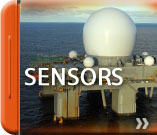MDA
U.S. Department of Defense
Skip to content. | Skip to global navigation | Skip to primary navigation
Ballistic Missile Defense System Sensors
August 20, 2011 - The SBX departs Vigor Shipyards after completing three months of scheduled maintenance and planned upgrades. |
||||
 |
 |
 |
 |
|
May 10, 2011 - SBX passes the Seattle skyline as it enters Elliott Bay just before arriving at Vigor Shipyards Seattle. Missile Defense Agency photos. |
||||
 |
 |
 |
 |
|
 |
 |
 |
 |
|
May 11, 2011 - Video footage of the SBX radar traveling towards Vigor Shipyards Seattle. |
 |
Jan. 9, 2006 - The Sea-Based X-Band radar arrives in Pearl Harbor, Hawaii, aboard the heavy lift vessel Blue Marlin on January 9, 2006, passing behind the U.S.S. ARIZONA Memorial. |
||||||
 |
 |
 |
 |
 |
||
 |
 |
 |
 |
 |
||
Space Tracking and Surveillance System (STSS)
Sept. 25, 2009 - The Space Tracking and Surveillance System - Demonstrator, or STSS-Demo, spacecraft lifts off through a cloud of smoke from Launch Pad 17-B at Cape Canaveral Air Force Station aboard a United Launch Alliance Delta II rocket. It was launched by NASA for the Missile Defense System. Launch was at 8:20:22 a.m. EDT on September 25, 2009. The STSS-Demo is a space-based sensor component of a layered Ballistic Missile Defense System designed for the overall mission of detecting, tracking and discriminating ballistic missiles. STSS is capable of tracking objects after boost phase and provides trajectory information to other sensors. |
|
|
|
|
 |
Both STSS Demonstration satellites are shown in their tandem flight configuration in this artist’s concept. |
||||||
An STSS demonstration satellite is shown in flight in this artist’s concept.. |
||||||
STSS demonstration satellite’s sensor payload illustrated. |
||||||
This illustration shows the tandem launch configuration for the STSS demonstration satellites. |
||||||
Aegis Launch on Remote Capabilities: The yellow area shows the area defended by Aegis radar alone. The green area is the area defended by ground radar if cued by other BMDS assets. The violet area shows the area defended using STSS information to launch and engage threat. |
||||||
Army Navy / Transportable Radar Surveillance (AN/TPY-2)
2009 AN/TPY-2 Photos
December 2-3, 2009 -
AN/TPY-2 Equipment during an ice test at the McKinley Climatic Lab, Eglin Air Force Base, Florida. |
Cooling Equipment Unit |
Electronic Equipment Unit |
Portable Power Unit |
|||
August 7, 2009 -
AN/TPY-2 Radar System at -28C during natural environment testing at the McKinley Climatic Lab, Eglin Air Force Base, Florida. |
|
|
|
|||
2008 AN/TPY-2 Photos
October 24, 2008 - AN/TPY-2 in Juneau, Alaska. |
AN/TPY-2 Radar site |
AN/TPY-2 operating in Forward Based Mode |
|
|||
Selected AN/TPY-2 Photos
|
|
|
|||
AN/TPY-2 operating in Forward Based Mode at White Sands Missile Range, New Mexico, in preparation for a flight test. |
|
|
|
|||
AN/TPY-2 Cooling Equipment Unit (Left) , Antenna Equipment Unit (Right) , and Electronic Equipment Unit (Center) operating in Forward Based Mode at Wake Island in preparation for Flight Test FTM-15. |
|
|
|
|||
AN/TPY-2 Antenna Equipment Unit operating in Forward Based Mode at White Sands Missile Range, New Mexico. |
|
|
|
|||
Upgraded Early Warning Radars (UEWR)
Selected UEWR Photos
Near Field Infrared Experiment (NFIRE)
Sept. 23, 2008 - At 11:57 pm PDT, September 23, 2008, a modified Minuteman II booster vehicle with a simplified target payload was launched from Vandenberg Air Force Base, Calif., and was successfully tracked by the orbiting Near-Field Infrared Experiment (NFIRE) research satellite. (USAF Photos) |
||||||
|
|
|
||||
Aug. 23, 2007 - On August 23, 2007 a modified Minuteman II booster vehicle was launched from Vandenberg Air Force Base, Calif. and was successfully tracked by the NFIRE satellite. |
|||||
|
|
|
|||
April 24, 2007 - On April 24, 2007 the Near Field Infrared Experiment (NFIRE) satellite was successfully launched from the NASA Space Flight Facility, Wallops Island, Virginia. The primary mission of the NFIRE satellite is to collect high and low resolution images of a boosting rocket to improve understanding of missile exhaust "plume" observations and plume-to-rocket body discrimination during three plume signature types: targets of opportunity, dedicated missile fly-bys, and ground observations. (Photos courtesy of NASA) |
|||||
Cobra Dane Radar at Eareckson Air Station, Shemya Island, Alaska." |
||||||
|
|
|
||||




























































